Check valve for a pump: device, types, principle of operation and installation details
Installing a pump for a stable water supply to the house requires connecting additional fittings.A check valve for the pump is installed in the water supply system or on the suction pipe lowered into the well - a small but useful device.
Do you want to equip your pumping system with check valves yourself, but don’t know how to do it correctly and which valve is suitable for these purposes?
We will help you understand the issue - in this material we suggest that you familiarize yourself with the design, operating principle of a check valve, and the main types. We will also provide step-by-step instructions for installing it.
The content of the article:
Purpose and principle of operation of the valve
A check valve, like any device for a water supply system, is installed to protect the network from any changes in flow parameters. Simply put, so that water is supplied constantly, without stops or breaks, in the required volume.
A narrower purpose of the valve is to organize the movement of water in one direction and prevent its return movement.
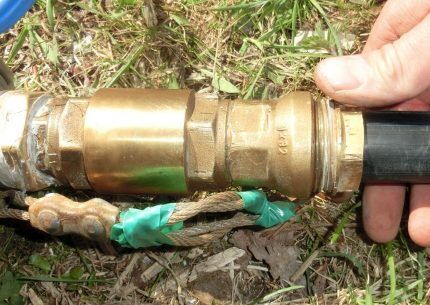
The problems solved by installing such a valve on the pump line:
- stabilizes pressure and water pressure when moving from a well or well;
- organizes the supply of water in the right direction - from source to consumer;
- keeps the highway constantly filled;
- protects equipment from pressure surges, force majeure situations and unscheduled repairs.
The operating principle depends on the type and design of the valve. Let's consider it using the example of a device intended for insertion into a pipe.
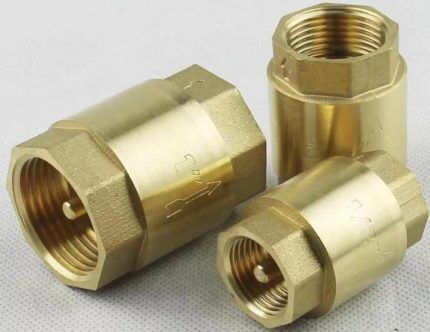
The main design elements of a check valve are two working parts: saddle And locking element. A spring is used to return the locking element to its original position.
The principle of operation of the check valve is simple. When liquid flows in the forward direction, from the source to the internal networks, the valve plate moves inside the housing, opening a gap for water. If the liquid moves in the opposite direction, the shut-off element is pressed tightly against the seat and completely blocks the flow area.
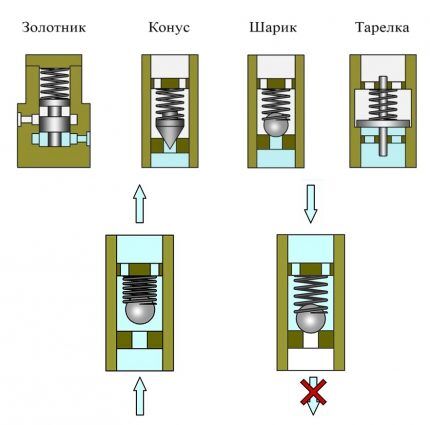
Without check valves, when the pump is turned off, the liquid, according to the laws of hydrodynamics, would go back into the well or well.
Types of back-locking devices
Based on the installation location, all check valves intended for pumping equipment are divided into two categories:
- for installation on the suction pipe of a surface pump or through an adapter to a submersible pump;
- for installation on a pipeline.
The former prevent the reverse movement of water and ensure that the system is constantly filled, the latter regulate water pressure.
We recommend installing both types of check valves, since the functions of the devices are different. The valve on the suction hose additionally protects the pump from “dry running”, prevents the occurrence of air locks, that is, it is responsible for the serviceability of the pump. Even if the equipment is initially equipped with a dry-running protection option, thanks to the check valve you will not have to constantly add water.
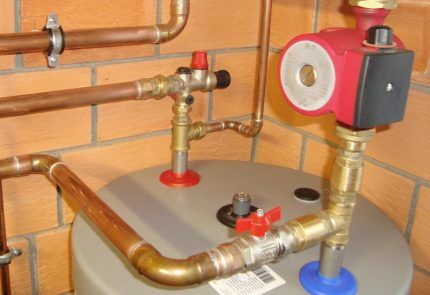
Valves, which are installed on the pipe in the internal wiring of the house, prevent the return of liquid to the outside - to the pump or well. They maintain the required water pressure and regulate pressure. The main function of pipe models is considered to be the protection of pumping and plumbing equipment from sudden pressure surges and water hammer.
Check valves for well pump
Check valves installed on the suction line are called bottom valves. They are used in a set of pumping stations to prevent water from draining from the network back into the well and maintain pressure at the required level.
The models differ in design. Typically, spring valves are used, less often - flap valves. If for spring ones the main working elements are a spring and a disk that blocks the flow, then for casement ones there are 1-2 doors that open under the pressure of the liquid.
The method of connecting the device to a pipe or hose also varies.Products with coupling method of fastening, less often - with flanged.

To prevent the valve from becoming clogged and sediment from the bottom of the source moving further into the pumping equipment, a filter with a fine mesh is installed underneath it.
Recommended topic: Check valve with mesh - selection and main characteristics.
Types of Pipe Check Valves
Depending on the installation conditions and the characteristics of the water supply system, valves are installed that differ in design, size, material and method of fastening. Some are intended for small-diameter pipes and domestic use, others for centralized water supply.
Let's look at the main classifications of check valves for water.
Classification #1 – by type of locking element
The part of the valve inside the body, responsible for closing the cross-section, comes in different configurations.
Based on the locking element, the following types of devices are distinguished:
- Lifting, in which the shutter device moves up/down depending on the presence or absence of water pressure in the pipe. The spring is responsible for the dynamics, and the spool acts as a shutter.
- Rotary, also equipped with a spool - a flap or “petal”. When the pump is turned on, it folds back and clears the way for liquid; when turned off, it slams shut, blocking the cross section.
- Double doors, blocking the path of water flow with two connecting flaps.
The movement of the locking element occurs parallel, perpendicular to the axis or at an angle, so manufacturers recommend installing some devices only on horizontal pipes, others on vertical pipes as well.
For domestic use, it is advisable to purchase spring valves, which are characterized by a simple design and ease of installation. If you decide equip yourself pumping system with check valves, we recommend this model.
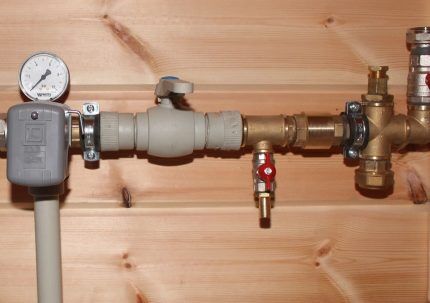
The design of the spring valve consists of the following elements:
- brass body (steel, polymer), consisting of two parts - a base and a cover with a saddle;
- disc element with a rubber seal that rests on the saddle;
- stock, performing the functions of centering and holder;
- spring to return the locking element to its initial state.
Valves such as rotary valves are almost never used in domestic water supply, but are often used for industrial pipelines, the diameter of which reaches 0.5 and even 1.5 m.
Classification #2 – by type of fastening
Tapping into a pipe is carried out in various ways, which are chosen depending on the pipe material and installation conditions.
Four types of valves are recognized as the most acceptable:
- flanged;
- wafer;
- coupling;
- welded
In systems associated with pumping stations, it is advisable to use a coupling type with a spring mechanism and simple installation. But in more “serious” networks, for example, for water supply equipment in an apartment building, all of the above types are successfully used.
If you decide to install a check valve in your home pumping network, you should choose a coupling model. Devices can be purchased in specialized stores at prices ranging from 40 to 600 rubles. Product sizes – 1ˮ, 1/2ˮ, 3/4ˮ.
Classification #3 – based on material of manufacture
Valve bodies are made from materials that reliably protect the internal mechanism and do not deform from the influence of the external environment and liquid flowing through pipes.
A check valve for a pipe can be:
- steel;
- cast iron;
- bronze;
- brass;
- plastic.
Products installed near centrifugal pumps in the heating system must be metal, since plastic is not intended for hot water.

Cast iron valves are characterized by heavy weight and roughness of the material. But they are not used for equipping autonomous home networks, but are installed only for industrial use on large-diameter pipes.
Devices from plastic lightweight and inexpensive, installation is very quick. But they cannot be applied to serious home water supply systems.
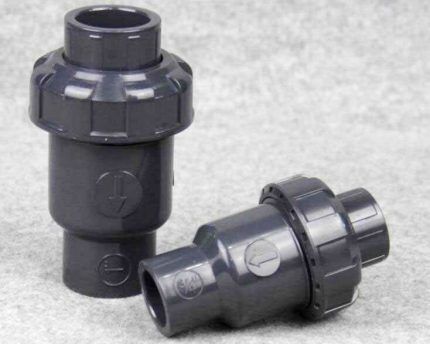
The internal parts - seat, valves, stem - of valves are made of polymers, stainless steel or aluminum. They are durable and resistant to corrosion. The active element, the spring, is made from a special spring steel, having an extended service life.
In valves installed on centralized pipelines and industrial facilities that can withstand heavy loads, plastic or rubber seals.
Recommendations for installing such a valve
Let's consider one of the options for installing a check valve - on a submersible pump "Aquarius". The device is connected directly to the pump. As soon as the unit stops working, the valve shuts off the water so that it does not drain back down. Thanks to this, the line is constantly filled with liquid.
The procedure for connecting the bottom check valve:
If there is no arrow on the check valve indicating the movement of water, you can try to blow it out. The valve is screwed to the pump on the side from which it is freely blown.
There are several rules regarding the location of the valve inside the well. If it is installed on a surface pump pipe, then the distance to the bottom must be at least 0.5 m. The manufacturer indicates the exact parameters in the technical data sheet. Also maintain a distance to the surface of the water - at least 0.3 m.

We recommend that you follow the following order: at the entrance you should install ball valve, then a strainer, followed by a meter, and only then a check valve.
Some metering devices are equipped with built-in valves, but they are not very reliable, so it is better to play it safe and install a separate device.
Conclusions and useful video on the topic
Recommendations for selecting and installing a check valve for a submersible pump:
More details about the design and purpose:
About the nuances of installing the valve in the following video:
There is no point in discussing the need to install check valves - this device is mandatory for the stable operation of the water supply system. It is also used with submersible, and with surface pumpsto extend the life of the equipment and protect the system from accidents.
Do you have experience installing a check valve? Or would you like to ask our experts or more experienced users for advice? Ask your questions and share your own opinions in the comments block located below this article.




There were malfunctions in the automation and hydraulic accumulator, the water began to flow in jerks and with air. After turning off the mains and turning it back on, it also jerks with air. I turned on the pump separately, it works fine. And when I turned it off, I realized the reason. The sound of water flowing back into the well was heard; the check valve installed on the pump had failed. I bought a check valve, replaced it, everything works.
I plan to install a deep-well pump on the site. We will only use water in the summer. In this regard, the question arose about where it is better to install a check valve, since the system will need to be drained before winter.
And in general, maybe someone knows the procedure for installing all the elements of a pump with an automatic machine, taking into account the summer use of the pump.
Good afternoon.There is no connection between the installation location of the check valve and draining water from the system for the winter. In any case, the valve is installed on the pump between it and the pipe that is laid from the well into the house. The drain is a different system that is not associated with a check valve. It all depends on what part of the water supply needs to be freed from water. If completely, then the drain device, and this is often an ordinary valve built into the side of the main line, is installed near the well. If the street part of the water supply is thermally insulated, then the valve is mounted inside the house near the surface of the internal wall through which the pipe from the pump passes.
How to install a check valve on a submersible pump?
How to install a check valve on an Aquarius submersible vibration pump?